Dutch cooking stove: features of the device
Heating and cooking stoves made of brick are actively used to heat country houses and at the same time they do not lose their relevance even in modern times. They may have different designs, differing both in their functionality and appearance. This article focuses on the so-called "Dutch".
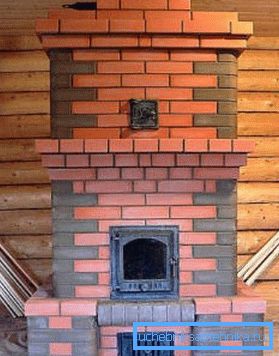
General provisions
The origin of such a specific name is not precisely known, but there are still two versions:
- The model itself was imported from Holland after which it became known as the Dutch.
- Dutch tiles were used to decorate the stove.

In any of the options gaining the popularity of the Dutch falls on the days of Peter the Great. At the same time, it was originally used exclusively for heating purposes, but later a hob was added to its design, which allowed it to expand the functions performed by the stove.
In the form in which the furnace equipment in question is used now, it has the following distinctive qualities:
Merits
- Large volume of a fire chamber, which particularly stands out from the compact size of the stove itself. This allows you to reduce the frequency of laying wood for heating.

- Simplicity of operation by the hands at the expense of the thought-over and convenient design. The main thing in time to fill the firewood firewood.
- Uniform heating of the entire furnace volume due to the peculiarities of the structure of internal channels.
- The maximum temperature located on the outside of the bricks reaches seventy degrees Celsius.
- Long lasting heat retention. The design remains heated for a long time after all the fuel has been burned out.
- The possibility of using both multi-channel and bell-shaped construction for the distribution of gas emissions.
- Attractive appearance. The Dutchwoman will decorate any country house, giving its interior a freshness and aesthetics.

- High performance.
- Multifunctionality. The additional presence of the cooking stove allows cooking on it using the heat energy of the firebox.
- Acceptable operating cost due to economical use of fuel materials.
- Long operational life, reaching twenty-five years with timely maintenance.
Tip: It is recommended to clean the chimney at least two times during the heating season. This will increase the life of the furnace.
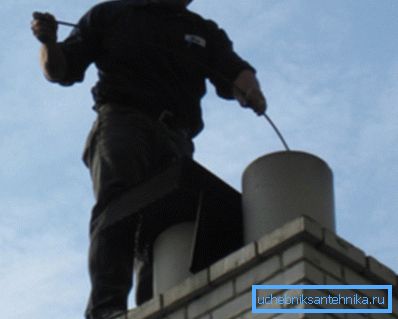
Technical Information
The most common is dvuhkolpakovaya heating and cooking model of the Dutch:
Design and principle of operation
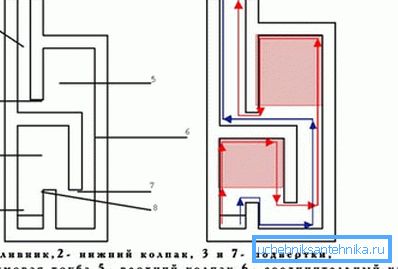
| Designation in the figure | Item Name |
| one | Firebox |
| 2 | The first cap of the lower location |
| 3, 7 | Subvert |
| four | Chimney |
| five | Second cap top location |
| 6 | Connecting channel |
| eight | Firebox threshold |
Firewood, burning in the furnace, emit gases that rise to the bottom cap. After that, they pass through the smoke channel and end up in the upper chamber. At the same time, 80% of all heat energy remains in the initial compartment, due to which the furnace heats up more evenly.
The main advantage of this design is that the cold air masses entering the stove pass by the already heated chambers through the entire structure.
Tip: to increase the efficiency of the lower part of the turn, which is indicated in the figure by the number "3", it is recommended to wear an iron case. Such an additional element removes heat and creates additional sealing.
Assembly stages
The installation instructions of the Dutch woman are as follows:
- We carry out preliminary preparation of clay for the binding solution, having soaked it in water for 48 hours. It should have a uniform creamy state.
- Then we prepare the solution itself using the ingredients and ratios from the table:
| Ingredient name | Quantity, kg |
| Sand | ten |
| Clay | ten |
| Water | 2.5 |
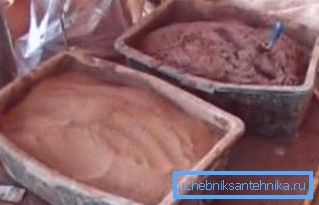
- Pre-fold the model of the furnace without using a solution. This will help eliminate typical errors and select the optimal configuration. In addition, this method significantly reduces the time of subsequent installation.
- Masonry perform strictly in accordance with the drawings. The position of each brick is worth checking the level, if you want to end up with a beautiful and smooth structure.
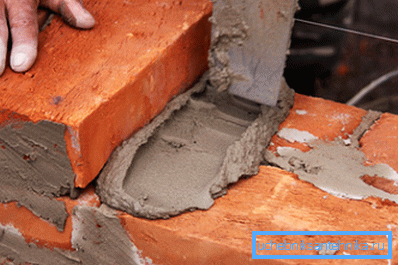
Tip: if the erection of the furnace structure is carried out in dry weather, then it is recommended that each brick be dipped into the water before lubrication. Due to this, the binding mixture will dry more evenly.
- Press the bricks as hard as possible, if necessary, we tap them with a hammer, since the thickness of the mortar from clay should not exceed five millimeters.
- We install the doors of different chambers, observing the minimum clearance. To install the largest door of the firebox, we make slots in the bricks under the wire, and use it to fix it.
- After completion of the laying, the drying phase begins. In the ideal case, the structure should dry naturally, but in the case of rainy weather, the process can be accelerated by burning paper and small chips.
Materials

For the standard model of 0.77 m by 0.77 m, you will need:
| Title | Quantity, pieces |
| Red brick of perfect quality | 370 |
| Fire brick for firebox | 150 |
| Door for firebox | one |
| Door for blew | one |
| Doors for cleaning | five |
| Views | 2 |
| Grate | one |
The power of the Dutchwoman, composed of the listed materials according to the specified method, will be 2.1 kW. You can always, of course, buy a ready-made version, but it will be much more expensive.
Conclusion
If you are the owner of a country house or are planning to build it, then one of the best ways to realize its heating will be the construction of a Dutch heating furnace. It has high performance, durability and aesthetics. With enough desire, you can create it on your own, adhering to the recommendations outlined in the article.

On the presented video you can familiarize with the additional materials having a direct bearing on the considered topic. Use only the best solutions for your home.